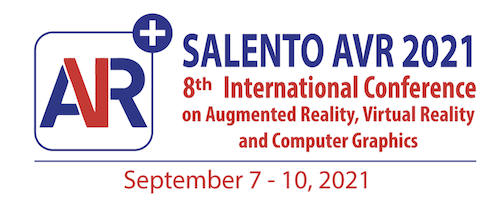TUTORIAL 1
Virtual Reality and Augmented Visualization in Medicine and Surgery
Lucio Tommaso De Paolis
AVR Lab, University of Salento, Lecce, Italy
In medicine and surgery the Virtual Reality technology has made available new tools for diagnosis and therapy definition by translating the information contained in the medical images of the patients into 3D virtual models who are realistic replicas of real patients with their actual pathologies. This has allowed the development of a new form of medical education and training and the use of patient-specific surgical simulators has permitted to practice and rehearse the surgical procedures on digital clones of the real patients. New applications of Augmented Reality technology, by means of the overlapping of virtual information on the real patient, provide systems that help surgeons in the intra-operative phase and permit to perform their tasks in ways that are both faster and safer. The use of the augmented visualization in surgery has the potential to bring the advantages of the open-surgery visualization also in the minimally invasive surgery.
Lucio Tommaso De Paolis is an Assistant Professor of Information Processing Systems and the scientific responsible of the Augmented and Virtual Reality Laboratory (AVR Lab) at the Department of Engineering for Innovation of the University of Salento, Italy; he is also the responsible of the “Advanced Techniques of Virtual Reality for Medicine” research group of the DReAM (Laboratory of Interdisciplinary Research Applied to Medicine) located at the Fazzi Hospital of Lecce, Italy.
He received the Master Degree in Electronic Engineering from the University of Pisa (Italy) in 1994 and after, first at the Scuola Superiore S.Anna of Pisa and then at the University of Salento, his research interest concerns the study of realistic simulators for surgical training and the development of applications of Virtual and Augmented Reality in medicine and surgery.
De Paolis has been in 2012 visiting professor at the Vytautas Magnus University of Kaunas (Lithuania), in 2011 visiting professor at the University of Tallinn (Estonia), in 2007 and 2010 visiting researcher at the Centro de Ciencias Aplicadas y Desarrollo Tecnológico (CCADET) – Universidad Nacional Autónoma de México (UNAM) – Mexico City (Messico), and in 2007 and 2009 visiting researcher at Computer Graphics Laboratory, Sabanci University of Istanbul (Turkey).
TUTORIAL 2
Development of Immersive VR Applications Using XVR
Marcello Carrozzino
PERCRO Lab, Scuola Superiore S. Anna, Pisa, Italy
The tutorial will explain the basics on how to program a in immersive VR application using the XVR technology, tackling general VR framework considerations and focusing on the most recent development in the field of managing immersive devices such as CAVEs and HMDs. Live examples of CAVE and Oculus Rift-based XVR applications will be provided, together with interesting insights on the uses of such technologies for mixed reality applications.
Marcello Carrozzino is an Assistant Professor of Computer Graphics and Virtual Reality. His activities deal with the integration of Virtual Reality systems and Cultural Heritage applications. Since 2005 he has been teaching the course of Virtual Environments held at the Computer Science Department of the University of Pisa. In 2006 he attained a Ph.D. at Scuola Superiore S. Anna in Pisa with a thesis on Efficient Management of Complex Virtual Environments. From 2006 to 2009 he has been Assistant Professor at IMT Lucca in the area of Technology and Management of Cultural Heritage. He is a founder of VRMedia s.r.l, a spin-off company of Scuola Superiore S. Anna in Pisa. Since 2000 he has been collaborating with Scuola Superiore S. Anna, where he is currently heading the Art, Cultural and Education Group of PERCRO Lab. He is a founder of the Mnemosyne Digital Culture association and has participated to several EU research projects, leaded regional projects, and authored or co-authored more than sixty publications in journals, conference proceedings and book chapters.
